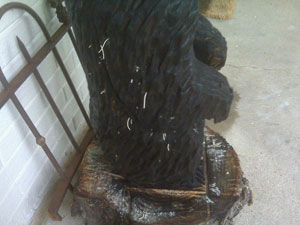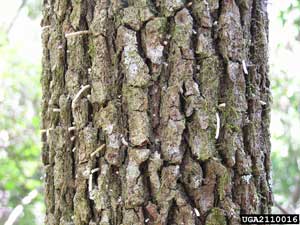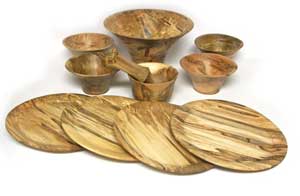It all started with a cry for help.
Early last year, I read an interesting entry on a foresters’ forum. A reader explained that she was given a wooden chainsaw-carved bear by her father. A few days after she received, it she noticed that it was growing “hair.” Lauren wrote, “I noticed some things growing out of the sides of the bear that look like little white strings, about 2 inches long. I got a broom and brushed them off, and within 2 hours of me brushing them off, they had already started to grow back!” She had no idea what was happening with her new gift, and most of the good folks who replied didn’t either. Most of them guessed it was fungus of some sort. They were close, but it was far too early to call it a fungus. Confused yet? Check out this photo:

What Lauren was seeing was frass. More specifically, it was the frass of an ambrosia beetle, most likely, the Redbay Ambrosia Beetle. The female beetle does not feed on wood but rather bores holes through the wood to build a chamber in which to lay eggs. The resulting “sawdust” or frass is forced out of the small hole and extrudes in long strands from the host wood. Normally, ambrosia beetles attack small limbs of live trees, or recently cut trees and green lumber.

Now the fungus part: as the beetle chews its way through the wood, it spreads the spores of the ambrosia fungus, which begins to grow in the wood. The beetle and the fungus do quite well together. The fungus is given a great place to live, rent-free, and when the beetle’s eggs hatch, they have a ready supply of nourishing fungus on which to feed.
Works out just fine for them, but what does it do to the tree? As the fungus grows, it begins to decay the wood around the beetle’s burrows. This causes the wood to stain and darken. The decay of wood as seen in affected sawn boards by different varieties of fungi is known as “spalting.” Spalting can wreck wood grade in mainstream lumber mills. The large mills’ moneymaker lumber is grade “firsts” and “seconds,” and to attain the grade, the lumber can have no “defects” such as spalting. There is no doubt that severe infestations will absolutely ruin lumber cut from that tree.
However, if the timing is right, the specialty mills, especially those selling maple direct to woodworkers, see dollar signs. If the spalted maple is sawn early enough in the process, before the wood has rotted, it can produce some beautiful “figure” in the wood. No one recognizes that quicker and values it higher than woodturners.
“Ambrosia maple” has developed as a trade name for spalted maple. Most times it is the result of ambrosia beetle and the subsequent fungal attack, but sometimes it’s not. However, the term describes all maple with similar characteristics so the inaccuracy is excusable. The following photo contributed by Mike Staten of Mikes Woodwork by Design (www.mikeswoodwork.net) is a wonderful example of ambrosia maple turned into a thing of beauty. 
So, if you hear news of an attack of the ambrosia beetle and how devastating it is to some tree or another, there is probably a bowl turner somewhere trying to hide feelings of glee. And if someone you know has a tree that is growing “hair,” you may want to volunteer to take the “ruined” tree off their hands.







